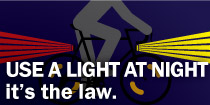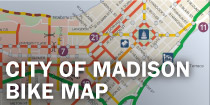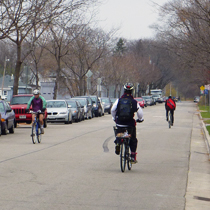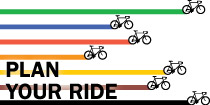Commuting by bike is often the quickest and most efficient mode of travel for trips of five miles or less. Many bicyclists also commute longer distances. Biking to and from work or school is not only a healthy way to get exercise, but also a great way to save gas money and wear and tear on your car!
GETTING READY FOR YOUR COMMUTE
- Looking for a bike buddy? Register with RoundTrip and search for someone to ride with. If you start commuting by bike three or more days per week, register for the Dane County Emergency Ride Home program through your RoundTrip account, in case an emergency occurs while you're at work.
- Check that your bicycle is in good working condition, especially if you haven’t ridden for a while.
- Check with your doctor if you have concerns about starting an exercise program.
- Choose your route carefully. The best route to work by bicycle may not be the same way you drive. Try a few different routes to find one that you like.
- Plan where to park your bicycle. Lock it securely to an available bike rack, or in a location where it does not get in the way of others. U-shaped locks work best to deter theft.
- Wear a helmet. Studies have shown that there is benefits to wearing a helmet even though it can't protect you from injury in every type of crash. Protect yourself from the unexpected by wearing your bicycle helmet every time you ride.
- Use lights and reflectors to increase your visibility, even if you do not plan to ride at night. A white headlight and a red rear reflector are required to bike at night.
- Use a rack, baskets or a backpack if you need to carry things on your bicycle. Be sure to keep your hands free to control your bicycle and signal turns. Packages can be strapped to a rack, or placed in bags (panniers) that attach to a rack. Use a trailer to carry large or heavy loads.
- Use eye protection to keep bugs & dirt out of your eyes. Sun glasses can also help reduce glare from the sun.
- Take extra care in wet weather. Streets are slippery when wet, especially painted surfaces, metal plates, railroad tracks and oil-slicked areas. Be aware of wet leaves and of puddles that may hide potholes. Your brakes do not work as well when your rims are wet. Ride slower, stay alert and start slowing down earlier.
- Wear layers in cooler weather. Breathable layers help you avoid getting too hot, and can be added or removed to stay comfortable. A wicking inner layer and a windproof outer layer are recommended.
- Be smart with your gears. On multi-geared bicycles, use an easy enough gear to let you pedal easily by shifting gears as terrain, road surface and winds change. Shift into an easier gear before stopping, especially at a stop sign or red light, to make starting up again easier.
- Stay hydrated. Drinking lots of water is very important, no matter what temperature you are riding in especially if you have a long commute.



